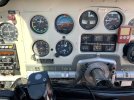- Joined
- Jul 29, 2011
- Messages
- 1,018
- Display Name
Display name:
MountainDude
It's very frustrating that engineers built such a complicated fuel system that can kill a very experienced pilot. Why not have a "both" setting?

 www.flyingmag.com
www.flyingmag.com
"In order to understand how a man described by his old friend as a “really good” pilot who was “knowledgeable” and “particular” about how he operated an airplane, one must first understand the fuel system of the M35.
The airplane had two main fuel tanks of 25 gallons each and two optional auxiliary tanks of 10 gallons each for a total capacity of 70 gallons. Its 260 hp engine burned around 14 gph in cruise. The fuel injection system of the IO-470, like all Continental fuel injection systems, pumped more fuel than the engine needed and sent the unused portion back to a tank. According to the airplane handbook, the vapor return amounted to 10 gph. If a main tank was selected, the vapor return went to it. If the aux tanks were selected, which fed simultaneously, the vapor fuel went to the left main.
This arrangement had several implications. One was that even though the engine was burning only 13 or 14 gph, the 20 gallons of auxiliary fuel would be gone in less than 50 minutes. Another was that if the aux tanks were selected before there was space for the return fuel in the left main, the return fuel would be vented overboard. The POH discouraged switching to the auxiliary tanks before the left main was half empty."

It’s Up to Pilot to Ensure Quirk Doesn’t Turn Into Pitfall
On the return flight, the pilot burned fuel from the right tank for the first 49 minutes. He then made a fateful decision: He selected the aux tanks.
"In order to understand how a man described by his old friend as a “really good” pilot who was “knowledgeable” and “particular” about how he operated an airplane, one must first understand the fuel system of the M35.
The airplane had two main fuel tanks of 25 gallons each and two optional auxiliary tanks of 10 gallons each for a total capacity of 70 gallons. Its 260 hp engine burned around 14 gph in cruise. The fuel injection system of the IO-470, like all Continental fuel injection systems, pumped more fuel than the engine needed and sent the unused portion back to a tank. According to the airplane handbook, the vapor return amounted to 10 gph. If a main tank was selected, the vapor return went to it. If the aux tanks were selected, which fed simultaneously, the vapor fuel went to the left main.
This arrangement had several implications. One was that even though the engine was burning only 13 or 14 gph, the 20 gallons of auxiliary fuel would be gone in less than 50 minutes. Another was that if the aux tanks were selected before there was space for the return fuel in the left main, the return fuel would be vented overboard. The POH discouraged switching to the auxiliary tanks before the left main was half empty."



